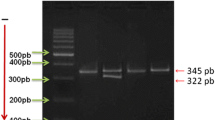Summary
To study the variation and significance of plasma coagulation factor VII (FVII) in different kinds of ischemia heart disease (IHD) and examine its relation with plasma lipid and gene polymorphism. FVIIa was determined with one stage clotting assay by using a recombinant soluble tissue factor (rsTF). FVIIc was measured with one stage clotting assay. FVIIag was quantified with an enzyme-linked immunosorbent assay (ELISA). Polymorphism was analyzed with PCR-urea-polyacrylamide gel electrophoresis. Our results showed that FVIIa in stable angina (SA), unstable angina (UA), obsolete and acute myocardial infraction (OMI, AMI) patients was higher than those of normal group with the differences being significant within any two groups. FVIIag in UA, OMI and AMI was higher than those in SA and normal groups. There were positive correlations between FVIIa and serum triglycerides, FVIIa and FVIIc, FVIIc and FVIIag. FVII-323 0/10 bp polymorphism analysis was performed in 60 patients and 0/10 bp polymorphism was found in 5 cases. FVIIc and FVIIag were much lower in cases of 0/10 bp groups than those in cases of 0/0 bp groups. It is concluded that there was activation of extrinsic coagulation pathway in every kind of IHD to different extent. FVIIa was the risk factor in the development of IHD, and more sensitive in reflecting the severity of cardiovacutar disease than FVIIc or FVIIag. FVIIa was higher in OMI, which may be one of the risk factors of re-infraction. Serum triglyceride may indirectly lead to the development of IHD by increasing the level of FVIIa. FVII-323 0/10 by polymorphism was present in Chinese patients with IHD and it was correlated with the level of FVIIc, FVIIag in plasma. 10 bp allelomorphic gene was a protective factor against thrombogenesis.
Similar content being viewed by others
References
Meade R W, Mellows S, Brozovic M et al. Haemostatic function and ischaemic heart disease: principal results of the northwick Park Heart Study. Lancet, 1986,2:533–537
Augusto D, Andria D, Contetta A et al. Genetic modulation of coagulation factor VII plasma levels: contribution of different polymorphisms and gender-related effects. Thromb Haemost, 1998,80:592–597
Kario K, Miyata T, Sakata T et al. Fluorogenic assay of activated factor VII. Plasma factor VIIa level in relation to arterial cardiovascular disease in Japanese. Arterioscler Thromb, 1994,14:265–274
Ossei-Gerning N, Wilson I J, Grant P J et al. Sex differences in coagulation and fibrinolysis in subjects with coronary artery disease. Thromb Haemost, 1998,79:736–740
Larsen L F, Marckmann P, Bladbjerg E M et al. The link between high-fat meals and postprandial activation of blood coagulation factor VII possibility involves kallikrein. Scand J Clin Lab Invest, 2000,60:45–54
Kario K, Matsuo T, Hoshide S et al. Lipid-lowering therapy corrects endothelial cell dysfunction in a short time but does not affect hypercoagulable state even after long-time use in hyperlipidemic patients. Blood Coagul Fibrionolysis, 1999,10:269–276
Steve H, Anne T, Anne L et al. Low plasma levels of factor VIIc and antigen are most strongly associated with the 10 base pair promoter (−323) insertion than the Glutamine 353 variant. Thromb Haemost, 1996, 75:567–572
Ferdinand M, Vant H, Angela S et al. Two common functional polymorphisms in the promoter region of the coagulation factor VII gene determining plasma factor VII activity and mass concentration. Blood, 1999,93:3432–3441
Bladbjerg E M, Andersen-Ranberg K, Maat M P et al. Longevity is independent of common variations in genes associated with cardiovascular risk. Throm Haemost, 1999,82:1100–1105
Author information
Authors and Affiliations
Rights and permissions
About this article
Cite this article
Hu, Y., Xu, D., Sun, C. et al. Role of coagulation factor VII in pathogenesis of ischemic heart disease. J. Huazhong Univ. Sc. Technol. 26, 657–660 (2006). https://doi.org/10.1007/s11596-006-0607-3
Received:
Issue Date:
DOI: https://doi.org/10.1007/s11596-006-0607-3




